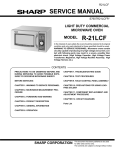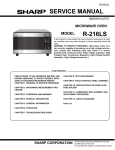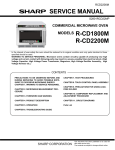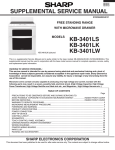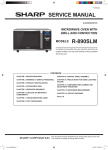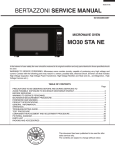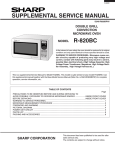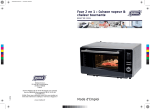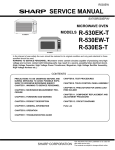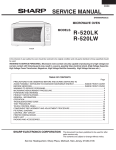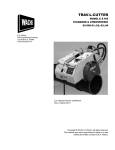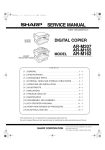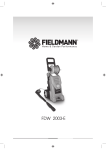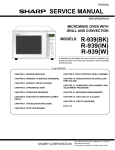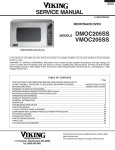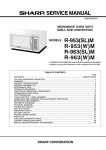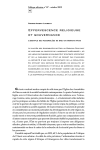Download VCSO210SS steam oven service manual
Transcript
VCSO210SS SERVICE MANUAL S52M342O210SS Combi Steam/Convect™ Oven VCSO210SS In the interest of user-safety the oven should be restored to its original condition and only parts identical to those specified should be used. WARNING TO SERVICE PERSONNEL: Microwave ovens contain circuitry capable of producing very high voltage and current. Contact with the following parts may result in a severe, possibly fatal, electrical shock. (Inverter unit that includes High Voltage Capacitor, High Voltage Power Transformer, High Voltage Rectifier and Heat sink etc., and Magnetron, High Voltage Harness etc..) TABLE OF CONTENTS Page PRECAUTIONS TO BE OBSERVED BEFORE AND DURING SERVICING TO AVOID POSSIBLE EXPOSURE TO EXCESSIVE MICROWAVE ENERGY........................................................... 2 BEFORE SERVICING............................................................................................................................................. 2 WARNING TO SERVICE PERSONNEL.................................................................................................................. 3 MICROWAVE MEASUREMENT PROCEDURE...................................................................................................... 4 FOREWORD AND WARNING................................................................................................................................ 5 PRODUCT SPECIFICATIONS................................................................................................................................ 6 GENERAL INFORMATION.................................................................................................................................... 7 Water supply/drainage schematic............................................................................................................ 9 TEST PROCEDURE............................................................................................................................................. 12 ERROR CHECK LIST........................................................................................................................................... 14 COMPONENT REPLACEMENT AND ADJUSTMENT PROCEDURE................................................................. 23 PICTORIAL DIAGRAM.......................................................................................................................................... 32 PARTS LIST ......................................................................................................................................................... 35 PACKING AND ACCESSORIES........................................................................................................................... 43 This document has been published to be used for after sales service only. Range Corporation 111 Front St., Greenwood, MS 38930 Tel: (888) 845-4641 1 VCSO210SS NOTICE In the interest of user-safety the oven should be restored to its original condition and only parts identical those specified should be used. WARNING TO SERVICE PERSONNEL: Microwave ovens contain circuitry capable of producing very high voltage and current. Contact with the following parts may result in a severe, possibly fatal, electrical shock. (High Voltage Inverter Unit, High Voltage Power Transformer, Magnetron, High Voltage Harness etc..) PRECAUTIONS TO BE OBSERVED BEFORE AND DURING SERVICING TO AVOID POSSIBLE EXPOSURE TO EXCESSIVE MICROWAVE ENERGY (a) Do not operate or allow the oven to be operated with the door open. (b) Make the following safety checks on all ovens to be serviced before activating the magnetron or other microwave source, and make repairs as necessary: (1) interlock operation, (2) proper door closing, (3) seal and sealing surfaces (arcing, wear, and other damage), (4) damage to or loosening of hinges and latches, (5) evidence of dropping or abuse. (c) Before turning on microwave power for any service test or inspection within the microwave generating compartments, check the magnetron, wave guide or transmission line, and cavity for proper alignment, integrity, and connections. (d) Any defective or misadjusted components in the interlock, monitor, door seal, and microwave generation and transmission systems shall be repaired, replaced, or adjusted by procedures described in this manual before the oven is released to the owner. (e) A microwave leakage check to verify compliance with the Federal Performance Standard should be performed on each oven prior to release to the owner. BEFORE SERVICING Before servicing an operative unit, perform a microwave emission check as per the Microwave Measurement Procedure outlined in this service manual. If microwave emissions level is in excess of the specified limit, contact Viking Service immediately @ 1-888-845-4641. If the unit operates with the door open, service person should (1) tell the user not to operate the oven and (2) contact VIKING, plus the Department Of Health, Canada and/or the Food and Drug Administration's Center for Devices and Radiological Health immediately. Service personnel should inform VIKING of any certified unit found with emissions in excess of 4mW/ cm2. The owner of the unit should be instructed not to use the unit until the oven has been brought into compliance. 2 VCSO210SS WARNING TO SERVICE PERSONNEL Microwave ovens contain circuitry capable of producing very high voltage and current, contact with following parts may result in a severe, possibly fatal, electrical shock. (Example) Inverter unit that includes High Voltage Capacitor, High Voltage Power Transformer, High Voltage Rectifier, Heat sink etc., and Magnetron, High Voltage Harness etc.. Read the Service Manual carefully and follow all instructions. Don't Touch ! Danger High voltage When all service work is completed and the oven is fully assembled, the microwave power output should be checked and microwave leakage test should be carried out. Before Servicing 1. Disconnect the power supply cord , and then remove outer case. 2. Open the door and block it open. 3. Wait for 60 seconds to discharge the high voltage capacitors of the inverter unit. 4. Disconnect the high voltage wire from the magnetron terminal with insulated pliers. 5. Make the terminal (metal part) of the high voltage wire contact to the magnetron body with insulated pliers. 6. Now, the capacitors of the inverter unit are discharged. 7. Reconnect the high voltage wire to the magnetron terminal after discharging. This inverter unit contains circuitry capable of producing high voltage and high current. Contact with any part of the high voltage will result in electrocution. WARNING: Use the pliers that the portions of their handles are insulated completely to avoid an electric shock. It is dangerous because this unit contains high voltage components. WARNING: RISK OF ELECTRIC SHOCK. After repairing 1. Reconnect all leads removed from components during testing. 2. Reinstall the outer case (cabinet) and the back plate assembly. 3. Reconnect the power supply cord after the outer case and the back plate assembly are installed. 4. Run the oven and check all functions. Microwave ovens should not be run empty. To test for the presence of microwave energy within a cavity, place a cup of cold water on the oven turntable, close the door and set the power to HIGH and set the microwave timer for two (2) minutes. When the two minutes has elapsed (timer at zero) carefully check that the water is now hot. If the water remains cold carry out “Before Servicing” procedure and re-examine the connections to the component being tested. 3 Servicing for Inverter Unit WARNING DO NOT ACCESS ANY PARTS OF INVERTER UNIT WITH POWER SUPPLY CONNECTED. DO NOT OPERATE INVERTER UNIT ITSELF. VCSO210SS MICROWAVE MEASUREMENT PROCEDURE A.Requirements: 1)Microwave leakage limit (Power density limit): The power density of microwave radiation emitted by a microwave oven should not exceed 1mW/cm2 at any point 5cm or more from the external surface of the oven, measured prior to acquisition by a purchaser, and thereafter (through the useful life of the oven), 5 mW/cm2 at any point 5cm or more from the external surface of the oven. 2) Safety interlock switches: Primary interlock relay switch shall prevent microwave radiation emission in excess of the requirement as above mentioned. Secondary interlock relay and door sensing switch shall prevent microwave radiation emission in excess of 5 mW/cm² at any point 5cm or more from the external surface of the oven. B. Preparation for testing: Before beginning the actual measurement of leakage, proceed as follows: 1) Make sure that the actual instrument is operating normally as specified in its instruction booklet. Important: USA Survey instruments that comply with the requirement for instrumentation as prescribed by the Federal Performance Standard for microwave ovens, 21 CFR 1030.10(c)(3)(i), must be used for testing. Canadian Survey instruments that comply with the requirement for instrumentation as prescribed by CSA and NHW performance standard for microwave ovens must be used for testing recommended instruments are , NARDA 8100 and NARDA 8200. 2) Place the load of 275±15 ml (9.8 oz) of tap water initially at 20±5O C (68OF) in the center of the oven cavity. The water container shall be a low form of 600 ml (20 oz) beaker with an inside diameter of approx. 8.5 cm (3-1/2 in.) and made of an electrically non conductive material such as glass or plastic. The placing of this standard load in the oven is important not only to protect the oven, but also to insure that any leakage is measured accurately. 3) Set the cooking control on a Manual Microwave Mode at full power. 4) Close the door and select a cook cycle of several minutes. If the water begins to boil before the survey is completed, replace it with 275 ml of cool water. C. Leakage test: Closed-door leakage test (microwave measurement): 1) Grasp the probe of the survey instrument and hold it perpendicular to the gap between the door and the body of the oven. 2) Move the probe slowly, not faster than 1 in./sec. (2.5 cm/sec.) along the gap, watching for the maximum indication on the meter. 3) Check for leakage at the door screen, sheet metal seams and other accessible positions where the continuity of the metal has been breached (eg., around the switches, indicator, and vents). While testing for leakage around the door, pull the door away from the front of the oven as far as is permitted by the closed latch assembly. 4) Measure carefully at the point of highest leakage and make sure that the highest leakage is no greater than 4mW/cm2, and that the primary interlock switch/secondary interlock relay does turn the oven OFF before any door movement. NOTE: After servicing, record data on service invoice and microwave leakage report. 4 VCSO210SS SERVICE MANUAL VIKING RANGE CORPORATION PRODUCT DESCRIPTION MICROWAVE OVEN VCSO210SS GENERAL INFORMATION FOREWORD OPERATION This Manual has been prepared to provide Viking Service Personnel with Operation and Service Information for the Viking Microwave Oven. It is recommended that service personnel carefully study the entire text of this manual so that they will be qualified to render satisfactory customer service. Check the interlock switches and the door seal carefully. Special attention should be given to avoid electrical shock and microwave radiation hazard. TROUBLESHOOTING GUIDE AND TEST PROCEDURE COMPONENT REPLACEMENT AND ADJUSTMENT PROCEDURE WARNING Never operate the oven until the following points are ensured: (A) The door is tightly closed. (B) The door brackets and hinges are not defective. (C) The door packing is not damaged. (D) The door is not deformed or warped. (E) There is no other visible damage with the oven. Servicing and repair work must be carried out only by trained service personnel. DANGER Certain initial parts are intentionally not grounded and present a risk of electrical shock only during servicing. Service personnel - Do not contact the following parts while the appliance is energized; Inverter unit (that includes High Voltage Capacitor, High Voltage Power Transformer, High Voltage Rectifier and Heat sink etc.) All the parts marked “*” on parts list are used at voltages more than 250V. Removal of the outer wrap gives access to voltage above 250V. All the parts marked “∆” on parts list may cause undue microwave exposure, by themselves, or when they are damaged, loosened or removed. VIKING RANGE CORPORATION 111 Front St., Greenwood, MS 38930 Tel: (888) 845-4641 5 WIRING DIAGRAM PARTS LIST VCSO210SS SPECIFICATION ITEM DESCRIPTION Power Requirements 120 Volts 10.7 Amperes (Microwave) / 12.5 Amperes (Convection) 60 Hertz / Single phase, 3 wire grounded Power Output 700 watts (IEC 705 Test Procedure) Operating frequency of 2450MHz Convection Power Output 1400 Watts Outside Dimensions Width 20-43/64" Height 16-5/16" Depth 18-5/16" (21” with handle) Cooking Cavity Dimensions (1.1 Cubic Feet ) (Stainless Steel) Width 13-36/64" Height 9-1/16" Depth 11-13/16" Control Complement Heating modes: Super Steam Convection Convection Steam Microwave Temperature control: o 200 ~ 450 F Microwave power: 0 ~ 100% Cooking time range: 0 ~ 2 hours 30 minutes Clock: 12 hour clock Oven Cavity Light Safety Standard Yes UL Listed FCC Authorized DHHS Rules, CFR, Title 21, Chapter 1, Subchapter J Canadian Standards Association. Health CANADA, Industry CANADA. 6 VCSO210SS OVEN COMPONENTS 1 1 2 3 4 5 6 7 8 9 10 11 12 13 14 15 16 2 3 4 15 16 12 5 14 6 7 8 9 10 13 Air vent opening Handle LCD display Contr ol panel Oven light Upper level Lower level Reservoir lid Reservoir Door gasket Latches Ceramic oven floor Door hinges Steam outlets Drip tray lid Drip tray 11 ACCESSORIES 17 17 18 19 17 High rack - For Steam Convection, Convection and Steam. Do not use when microwave cooking. Always place on baking tray. 19 Baking tray x 2 - For Steam Convection, Convection, Steam and Descale function. Do not use when micr owave cooking. 18 Low rack - For Steam Convection, Convection and Steam. Do not use when microwave cooking. Always place on baking tray. 20 Steam basket - For Steam. You can also use for Steam Convection and Convection. Do not use when microwave cooking. Place on high rack in baking tray. 7 20 21 21 Descaling guide VCSO210SS CONTROL PANEL Enter Dial Back/Info DISPLAY INFORMATION 2 3 1 1 Arrows indicate more than one page; when you see an arrow, you can turn the dial to move back and forth between pages. When there are no arrows, you can go back to the previous page by touching BACK/INFO. 2 The illustration at the top of display indicates the selected cooking mode. Steam Convection was selected. Steam was selected. Microwave was selected. Convection was selected. 3 Words will light in the display to indicate features and cooking instructions. 8 VCSO210SS Water supply/drainage schematic 1. When installing the reservoir ENGINE UNIT ASSEMBLY Water level sensor Water level unit Water supply tube to the engine assembly FEED-WATER RESERVOIR TUBE PUMP DEW TRAY Inserting the reservoir delivers water to the water level unit. 2. When steaming and supper steam convection operations Turning the heater ON generates steam. Activation of the pump delivers water to the engine through the tube. Dew condensation water in the oven cavity and the exhaust air duct is discharged to the dew tray 9 VCSO210SS 3. When removing the reservoir Remained water in the tube and the engine is not discharged even with the reservoir removed. Removing the reservoir discharges remained water in the water level unit to the dew tray. 4. When operating the oven in order to discharge remained water in the engine unit assembly and tube (“Drain water” mode). Remained water in the tube is delivered to the engine. Then the engine heater turn ON so as evaporate remained water in the engine unit assembly. Remained water in the tube is delivered to the engine unit. Make sure to remove the reservoir. Remained water in the water level unit and dew condensation water in the oven cavity and the exhaust air duct are discharged to the dew tray. 10 VCSO210SS On/Off Operation of Electric Parts in Each Heating Mode Signal Parts Microwave Out put Input Heating modes Convection Supersteam Steam Inverter unit ON OFF OFF OFF Primary interlock relay ON ON ON ON Engine heater Convection heater Super Steam heater Fan motor (AC motor) Cooling fan motor (DC motor) Ventilation fan motor (DC motor) Sirocco fan motor (Exhaust) Convection motor Pump motor Oven lamp Thermistor (Engine) Thermistor (Oven) Water sensor AH sensor Dew tray switch detection OFF OFF OFF ON ON ON ON OFF OFF ON OFF OFF OFF ON YES OFF ON OFF ON ON OFF ON ON OFF ON OFF ON OFF OFF YES 11 OFF ON OFF ON OFF ON ON ON OFF ON ON ON ON ON ON ON OFF YES ON OFF OFF ON ON OFF ON OFF ON ON ON OFF ON OFF YES VCSO210SS MAGNETRON ASSEMBLY TEST 1. 2. 3. 4. 5. 6. TEST PROCEDURES Disconnect the power supply cord, and then remove the outer case and the back plate assembly. Open the door and block it open. Wait for 60 seconds to discharge the high voltage capacitors of the inverter unit. Disconnect the high voltage wire from the magnetron terminal with insulated pliers. Make the terminal (metal part) of the high voltage wire contact to the magnetron body with insulated pliers. Now, the capacitors of the inverter unit are discharged. WARNING: Use the pliers that the portions of their handles are insulated completely to avoid an electric shock. 7. To test for an open filament, isolate the magnetron from the high voltage circuit. A continuity check across the magnetron filament leads should indicate less than 1 ohm. 8. To test for a shorted magnetron, connect the ohmmeter leads between the magnetron filament leads and chassis ground. This test should indicate an infinite resistance. If there is little or no resistance the magnetron is grounded and must be replaced. 9. Reconnect all leads removed from components during testing. 10.Reinstall the outer case and the back plate assembly. 11.Reconnect the power supply cord after the outer case and the back plate assembly are installed. 12.Run the oven and check all function. 1. MICROWAVE OUTPUT POWER The following test procedure should be carried out with the oven in a fully assembled condition (outer case fitted). HIGH VOLTAGES ARE PRESENT DURING THE COOK CYCLE, SO EXTREME CAUTION SHOULD BE OBSERVED. Power output of the magnetron can be measured by performing a water temperature rise test. This test should only be used if above tests do not indicate a faulty magnetron and there is no defect in the inverter unit or wiring. This test will require a 16 ounce (453cc) measuring cup and an accurate mercury thermometer or thermocouple type temperature tester. For accurate results, the following procedure must be followed carefully: 1. Fill the measuring cup with 16 oz. (453cc) of tap water and measure the temperature of the water with a thermometer or thermocouple temperature tester. Stir the thermometer or thermocouple through the water until the temperature stabilizes. Record the temperature of the water. 2. Place the cup of water in the oven. Operate oven at 100% power selecting more than 60 seconds cook time. Allow the water to heat for 60 seconds, measuring with a stop watch, second hand of a watch or the digital read-out countdown. 3. Remove the cup from the oven and again measure the temperature, making sure to stir the thermometer or thermocouple through the water until the maximum temperature is recorded. 4. Subtract the cold water temperature from the hot water temperature. The normal result should be 21.6 to 40°F(12 to 22.3°C) rise in temperature. If the water temperatures are accurately measured and tested for the required time period the test results will indicate if the magnetron tube has low power output (low rise in water temperature) which would extend cooking time or high power output (high rise in water temperature) which would reduce cooking time. Because cooking time can be adjusted to compensate for power output, the magnetron tube assembly should be replaced only if the water temperature rise test indicates a power output well beyond the normal limits. The test is only accurate if the power supply line voltage is 120 volts and the oven cavity is clean. PRIMARY INTERLOCK SYSTEM TEST- checking switches Before checking switches 1. Disconnect the power supply cord, and then remove the outer case and the back plate assembly. 2. Open the door and block it open. 3. Wait for 60 seconds to discharge the high voltage capacitors of the inverter unit. 4. Disconnect the high voltage wire from the magnetron terminal with insulated pliers. 5. Make the terminal (metal part) of the high voltage wire contact to the magnetron body with insulated pliers. 6. Now, the capacitors of the inverter unit are discharged. 7. Reconnect the high voltage wire to the magnetron terminal after discharging. WARNING: Use the pliers that the portions of their handles are insulated completely to avoid an electric shock. Isolate the switch and connect the ohmmeter to the terminals of the switch (refer to page 32 for each switch terminal location). Check all switches. If improper operation is indicated, replace the faulty switch. 9. Reconnect all leads removed from components during testing. 10.Reinstall the outer case and the back plate assembly. 11.Reconnect the power supply cord after the outer case and the back plate assembly are installed. 12.Run the oven and check all function. 12 VCSO210SS PRIMARY INTERLOCK SYSTEM TEST 1. 2. 3. 4. 5. 6. 7. Disconnect the power supply cord, and then remove the outer case and the back plate assembly. Open the door and block it open. Wait for 60 seconds to discharge the high voltage capacitors of the inverter unit. Disconnect the high voltage wire from the magnetron terminal with insulated pliers. Make the terminal (metal part) of the high voltage wire contact to the magnetron body with insulated pliers. Now, the capacitors of the inverter unit are discharged. Reconnect the high voltage wire to the magnetron terminal after discharging. WARNING: Use the pliers that the portions of their handles are insulated completely to avoid an electric shock. 8. Connect the ohmmeter to the white/white terminal of the noise filter and the white terminal of the convection motor. By doing so, the state of the relay contacts using a ohmmeter can be checked. The meter should indicate an open circuit. Because the relay contacts should be open. If the relay contacts are closed, replace the circuit board entirely or the relay itself. 9. Reconnect all leads removed from components during testing. 10.Reinstall the outer case and the back plate assembly. 11. Reconnect the power supply cord after the outer case and the back plate assembly are installed. 12.Run the oven and check all function. latch hook location left side - top left side - bottom right side - top right side - bottom Switch name 3rd Door Door Sensing Monitor Secondary Interlock Type door open N.O. closed circuit N.O. closed circuit N.C. open circuit N.O. closed circuit door closed open circuit open circuit closed circuit open circuit You can use a small screwdriver to push on the switch's plunger as shown for the monitor switch below. N.C. COM. MONITOR SWITCH SCREW DRIVER OHMMETER 13 VCSO210SS BLOWN MONITOR FUSE TEST 1. 2. 3. 4. 5. 6. 7. Disconnect the power supply cord, and then remove the outer case and the back plate assembly. Open the door and block it open. Wait for 60 seconds to discharge the high voltage capacitors of the inverter unit. Disconnect the high voltage wire from the magnetron terminal with insulated pliers. Make the terminal (metal part) of the high voltage wire contact to the magnetron body with insulated pliers. Now, the capacitors of the inverter unit are discharged. Reconnect the high voltage wire to the magnetron terminal after discharging. WARNING: Use the pliers that the portions of their handles are insulated completely to avoid an electric shock. 8. If the monitor fuse is blown when the door is opened, check the primary interlock relay, secondary interlock switch and monitor switch according to the ”PRIMARY INTERLOCK SYSTEM TEST” procedure for those switches before replacing the blown monitor fuse. CAUTION: BEFORE REPLACING A BLOWN MONITOR FUSE, TEST THE PRIMARY INTERLOCK RELAY, SECONDARY/THIRD INTERLOCK SWITCH, DOOR SENSING SWITCH AND MONITOR SWITCH FOR PROPER OPERATION. If the monitor fuse is blown by improper switch operation, the monitor fuse and monitor switch must be replaced with “monitor fuse and monitor switch assembly” part number FFS-BA038WRKZ, even if the monitor switch operates normally. The monitor fuse and monitor switch assembly is comprised of a 15 ampere fuse and switch. 9. Reconnect all leads removed from components during testing. 10. Reinstall the outer case and the back plate assembly. 11. Reconnect the power supply cord after the outer case and the back plate assembly are installed. 12. Run the oven and check all function. CHECKING TEMPERATURE IN THE CONVECTION (Bake or Roast) MODE The following test procedure should be carried out with the oven is a fully assembled condition (outer case fitted). It is difficult to measure the exact temperature in the convection oven. An accurate thermocouple type temperature tester must be used. A low priced bi-metal type thermometer is not reliable or accurate. Position the thermocouple in the center of the oven cavity. The temperature should be checked with outer case cabinet installed and set the oven temperature to 450°F in the convection mode (Bake or Roast). Approx. 10 minutes after preheat temperature is reached, the temperature experienced may be approx. 30°F more or less than set temperature, however, in most cases the food cooking results will be satisfactory. Difference in power supply voltage will also affect the oven temperature. The Household power supply voltage may sometimes become lower than the rated voltage (120V) and cause under-cooking. If the power supply voltage is 10% lower than the rated voltage, longer cooking time is required by 10% to 20%. ERROR LIST Error indication Wait. Oven is too warm to use. Description Inside temperature error Replace drip tray or empty drip tray and replace. Remove resevior No dew tray setting error No dew tray has been set. Reservoir with water presence error Freezing error There is water in reservoir when remained water is discharged. Low engine temperature error Water is frozen. Please refer to instructions in operation manual. Fill water reservoir. Not enough water Condition thermistor level is starting higher than it should be for the beginning of proof (fermentation) or defrosting. Lack of necessary amount of water Menu concerned Proof (fermentation) Defrosting No dew tray. Detection means Oven thermistor Dew tray switch Discharging remained water Water level sensor Engine usage menu Oven thermistor Engine usage menu Water level sensor 14 Check timing One (1) second after heating start Any time After one (1) second from start of heating (manually) As soon as heating starts After 30 seconds for automatic menu and after one (1) second from start of heating for manual operation Remarks Error message indication. When oven temperature is below 90C [194F] this error will is released" and cooking can resume. VCSO210SS E r r o r i n d i c a ti o n D e s c r i p ti o n EE01 Oven thermistor failure Short circuit Open EE02 AH sensor failure C o n d i ti o n Software is detecting oven Break/short-circuit stuck at too hot while in of thermistor oven mode or oven stuck C h e c k ti m i n g As soon as heating starts Any time during heating R ema rk s at too cold while in proof (fermentation) mode. Software and associated After 16~32 seconds from start A/D circuitry is measuring of microwave sensor cooking values outside of normal modes. range for AH sensor. Break/short-circuit of AH sensor EE05 High temperature engine error EE12 Engine thermistor failure EE14 EEPROM failure Data verification error Reset Food burning while microwave cooking Engine temperature is abnormally high. Break of thermistor Written value does not agree with read value AH sensor ladder resistance level error Engine usage menu Any time during cooking mode but microwave Engine usage menu Any time during heating When I/O check mode starts Judgment is carried out when engine heater has been energized for 30 or more seconds. I/O check mode After an elapse of seven (7) minutes from start of heating [7] How to check in the event of an error NOTE: HOW TO SET THE TEST MODE (Power ON/door closed state) [STOP/CLEAR] [STEAM CONVECTION] Within 1 sec. [MICROWAVE] Within 1 sec. [OPEN DOOR] Within 1 sec. (Set the number (initial number: 04) by [ENCODER DIAL] [DIRECT SETTING KEY] [START] 1. How to check water supply performance 1) Check of water level sensor performance Unplug the water tank, power on the oven, put oven into test mode 00. NO Is the oven in the following conditions? Test mode: 00 (see [9] TEST MODE page 21,22) H-side water level sensor: 00 h L-side water level sensor: 00 h Are there disconnection and short circuit in the water level sensor connectors, connecting between the board and the sensor section? NO YES Repair connector. Measure resistance of a set of the three (3) water level sensors with the sensor connecting connector pulled out of the board. YES Is the measured resistance value of the set infinite? Fill the tank with water to the water level 2 and plug tank into oven. After confirming that the water level sensor wiring of the water tank is OK, replace the Water Level unit. NO YES Replace the control board or the display board. Did water transfer from tank to Water Level unit? YES NO Is the unit in the following conditions? NO Test mode: 00 (see [9] TEST MODE page 21,22) H-side water level sensor: 80 (h) or more L-side water level sensor: 80 (h) or more YES Check/replace the connection between the tank and the Water Level unit. Are there disconnection and short circuit in the water level sensor connectors, connecting between the board and the sensor section? NO Do the H-side and L-side water level sensors indicate 01 or more in the test mode? YES End Is ion-changed or pure water being used? YES Use common tap water. NO NO YES Repair connector. Measure resistance of a set of the three (3) water level sensors with the sensor connecting connector pulled out of the board. (with the water tank filled with water) Is the measured resistance value of the set infinite? NOTE: If there is water touching/ covering the three water level sensors it is NOT infinite. You get anywhere from a few M ohms to a few hundreds of K ohms. YES NO Replace the control board or the display board. After confirming that the water level sensor wiring of the water tank is OK, replace the Water Level unit. 15 VCSO210SS Check of tube pump performance Hole of the angle base for the motor of the tube pump unit Measure the weight of the reservoir filled with water to water level 'A'g[oz]. Plug the tank into the oven and power ON. Start 11-minute steaming operation. To confirm the pump's roller is okay, observed through the hole of the angle base. Is the tube pump unit rotating? NO Is the connector between the motor terminal and board disconnected? NOTE: The motor operating the tube pump cycles On and Off. You YES After stopping the operation, connect/repair the connector. NO may have to observed for a few minutes to see the rotation. YES Is there a voltage of 120 VAC at the motor terminal? NO Press the STOP/CLEAR key to stop the operation. YES Confirm that water is flowing at the feed-water inlet of the engine. Replace the control board. Press the STOP/CLEAR key to stop the operation. YES NO Is there breakage or clogging in the tube? (Stop the operation.) YES Replace or repair the tube. NO Replace the motor or the pump unit. YES The 11-minute steam operation is finished (For the last one (1) minute, the tube pump does not run remaining oven moisture to discharged into the dew tray. *** refer to page 9: Dew condensation water in the oven cavity and the exhaust air duct is discharged to the dew tray. *** Open the door and swipe the remaining condensation from oven into the dew tray. Then close the door again. Empty the dew try then plug it back into the oven. Remove the tank from the main oven. After 20 seconds, remove the dew tray and return accumulated water in the tray to the tank. Is the weight reduction (= A - B) equal to or more than 150g [5.3oz]? Measure weight of the water tank. (Weight after the operation is 'B'g[oz]) NO YES Normal 2. How to check performance of sensors (AH sensor, water level sensors and Engine thermistor) Fill the tank to level 2 and plug it into the oven then power ON. (Confirm that there is no water remaining in the oven cavity.) Set the test mode to 10. [9] TEST MODE page 21,22) Press the START key. 16 second to air out oven then Microwave operates 100% power for one minute. AH sensor checked during that one minute. YES Is AH sensor failure (- - 10) indicated? NO EE02: Proceed to checking the AH sensor for failure. Steaming (strong) operation (for 20 minutes) starts. Steam Engine's Thermistor and water level sensor checked. The operation is finished. Is Engine thermistor failure (11 01) indicated? NO Is water level sensor failure (10 00 or 01 00) indicated? NO YES EE12: Proceed to checking the engine thermistor for failure. YES Normal Test mode #10 ends (11 11) 16 Go to 1) Checking performance of the water level sensor in page 15. VCSO210SS 3. How to check sensor (oven thermistor) performance Power ON the oven Power ON the oven Set the test mode to 03. (see [9] TEST MODE page 21,22) Press the START key. Does a measured value for the oven thermistor change as oven heating proceeds? NO YES Is the measured value within ±10 bits with respect to the reference value after about eight (8) minutes? NO EE01: Proceed to checking the oven thermistor for failure. YES Press the STOP/CLEAR key to finish the operation. (This action is required when everything is OK.) 4. EE01 Oven thermistor failure Is the connector between the oven thermistor and board either disconnected or shorted? YES Connect or repair the connector. NO Measure the oven thermistor resistance using a tester with the thermistor connecting connector pulled out of the board. The oven thermistor resistance is within its appropriate range. NO Replace the oven thermistor or the harness. YES Replace the control unit or the display unit. 5. EE02 AH sensor failure Has the humidity sensor connector been disconnected from the control board? YES Connect the connector. NO Measure element resistance between the opened and sealed sides of the humidity sensor with the humidity sensor connector disconnected from the board. G-3 S G-2 C G-1 Is the resistance 0? Resistance @25C F1 to F3 3kΩ F2 to F3 2kΩ ~ 3kΩ F1 to F2 5kΩ ~ 6kΩ 17 Replace the humidity sensor. NO Is the resistance infinite? Measuring YES YES Replace the humidity sensor. NO Is the resistance normal? YES Replace the control board. NO Replace the humidity sensor. VCSO210SS 6. EEO5 Engine high temperature failure Is the connectors between the engine thermistor, board and engine mounting section disconnected or short circuited? YES Connect/repair the connector(s) or replace the thermistor/harness. NO Measure the engine thermistor resistance using a tester with the thermistor connector pulled out of the board. The oven thermistor resistance is within its appropriate range. NO Replace the engine thermistor or the harness. YES Replace the control unit and the engine unit 7. EE12 Engine thermistor failure Is the connectors between the engine thermistor, board and engine mounting section disconnected or short circuited? Connect/repair the connector(s) or replace the thermistor/harness. YES NO Measure the engine thermistor resistance using a tester with the thermistor connector pulled out of the board. The engine thermistor resistance is within its appropriate range. � About 200 kW at � About 10 kW at � About 1 kW at NO Replace the engine thermistor or the harness. YES Are there disconnection, breakage and short circuit in the engine heater connections (the engine terminals and board)? YES Connect/repair the terminal(s) or replace the harness. NO Is there a voltage of 120 VAC between the engine heater terminals? NO The latch switch is in the door open position. YES YES Adjust the latch. NO Is the engine heater normal to meet the following requirements? Insulation resistance: One (1) M or more at 500 VDC Dielectric strength: 1000 V for one (1) minute Leakage current: 0.3 mA or less Resistance (in cold condition): 15.05 to 16.21 YES Is there a voltage of 120 VAC at each terminal of the E thermostat? NO Replace the Engine thermostat. YES NO Replace the engine unit. Replace the control board, the display board or the harness. 18 VCSO210SS Check and remedy in the event of malfunction 1. List Operation Trouble No display Action Has the 15 A fuse blown? YES: Refer to Check in the event of 15 A fuse blowing. NO: Check the display unit, fan thermal cut-out and convection thermal cut-out. Even with plugged in No key is valid. Replace the display unit. No backlight for display illuminates Replace the display unit. The rotary knob does not function. Replace the display unit. The oven lamp does not illuminate. Is there a voltage of about 120 V between the oven lamp terminals. YES: Replace the oven lamp. (Note that the lamp goes out after five (5) minutes from opening the door.) No sound NO: Replace the control unit. Has the harness between the control unit (CN-D) and the display unit (WH-A) been connected? YES: Replace the control unit or display unit. (Check that sound volume has not been set to mute.) NO: Connect the harness. The START key does not function. Also check that sound volume has not been set to mute. ( [BACK/INFO] --> select Sound ON/OFF, [ENTER] ) With door closed, check if door switch is open [YES] or closed [NO] (also a [YES] if the oven lamp does not go out). YES: Adjust the door switch. NO: Replace the control unit or display unit. The fan motor does not run. Is there a voltage of 120 V for the AC fan or 24 V for the DC fan? YES: Replace the fan motor. NO: Replace the control unit. When heating operation started The supersteam heater does not function. The engine heater does not function. The convention does not function. Is there a voltage of about 120 V between the terminals of each of the supersteam heater, engine heater and convection heater? YES: Raeplace the engine unit assembly (when the supersteam heater does not function). Replace the engine unit assembly (when the engine heater does not function. Replace the convection heater (when the convection heater does not function). NO: With door closed, check if any switches are measuring as if the door is in open position. YES: Adjust the latch. NO: The engine thermostat has been broken. YES: Replace the engine unit assembly, engine thermostat and the engine packing B. NO: Replace the control unit. The tube pump motor does not run. Is there a voltage of about 120 V between the tube pump motor terminals. YES: Replace the pump unit assembly.(Check the tube pump motor.) NO: Replace the control unit. Reset occurs. Others Even with the tank filled with water, "Fill water reservoir" is indicated and heating does not start. Replace the control unit. Has the reservoir been inserted all the way? YES: Replace the WL joint or the control unit. NO: Replace the tank or the tank spring. 2. Check in the event of a 15 A fuse blowing When the 15 A fuse was blown, observe the following instruction: There are many high voltage components in the oven, therefore, except for performing operational check, unplug the power cable before starting work. For the harness, check for poor caulking, poor connection, etc. Refer to page 14 “BLOWN MONITOR FUSE TEST” and if the fuse still continues to blow, the the inverter may need to be be replaced. 19 VCSO210SS INVERTER UNIT TEST WARNING: DO NOT TOUCH THE COMPONENTS OF THE INVERTER UNIT WHILE INVERTER UNIT IS ENERGIZED. IT IS DANGEROUS BECAUSE THIS HAS HIGH VOLTAGE COMPONENTS. CAUTION:Do not operate inverter unit by itself. CAUTION: Do not connect the oven to wall outlet without the outer case installed. Before checking the inverter unit, curry out following 4 steps. 1. Disconnect the power supply cord, and then remove outer case. 2. Open the door and block it open. 3. To discharge high voltage capacitor, wait for 60 seconds. 4. Make sure that the wire leads and the connectors are connected correctly to the inverter unit, control unit and magnetron. Chart for checking the defective inverter unit No power at full power output cooking Magnetron is defective. No Exchange the Inverter unit Yes Exchange the magnetron. Blown monitor fuse The secondary interlock switch, primary interlock No switch and the monitor switch are operating properly. YES Exchange the Inverter unit 20 Check the switches according to the switch Test Procedure VCSO210SS TEST MODE HOW TO SET TEST MODE (Power ON/door closed state) [STOP/CLEAR] [STEAM CONVECTION] Within 1 sec. No. [MICROWAVE] Within 1 sec. Test mode [OPEN DOOR] Within 1 sec. (Set the number (initial number: 04) by [ENCODER DIAL] [DIRECT SETTING KEY] Description Output 00 Monitoring of various A/D values Measured A/D values are displayed on one screen. [1] H-side water level sensor [2] L-side water level sensor [3] Oven thermistor (oven mode) [4] Oven thermistor (proofing mode) [5] Engine thermistor [6] Dew tray switch 03 Thermistor check Convection mode heating oven to 350F. Reference bits and C Heater, RY1 C Fan, OL measured temperature A/D values are displayed in hex. DC Fan (cooling) Exhaust Fan FM 10 AH with no load Steam (water level) check (1) Noise check with no water load placed inside oven AH judgment begins after [START] key. The first 16 seconds no microwave power (fans removing residual moisture). OFF FM, OL, RY3 DC Fan (cooling) DC Fan (ventilation) Exhaust Fan Microwave power on at 100% for 1 minute . Software is checking how much microwave noise the AH sensor is detecting. Some noise (less than 16 bits) is not a problem for normal AH sensor operation. However, noise levels of 16 bits or greater will trigger sensor fault before normal moisture has occurred. [Low moisture foods, like popcorn, depend upon good AH sensor operation.] Microwave (full power) FM, OL, RY3 DC Fan (cooling) DC Fan (ventilation) Exhaust Fan *In the event of sensor fault or 16 or more bits, not acceptable is indicated by “- - 10” and the test mode will not proceed next part, steam heating. Display example TEST00 Measured value WATER H XX [1] XX bits WATER L XX [2] XX bits OVEN TH XX Y Y [3] XX bits [4] YY bits ENG TH XX [5] XX bits DEW SW XX [6] XX bits TEST03 XX YY CONV Reference value XX bits Measured value YY bits AH judgment level indication TEST10 10 00 AH level indication in progress TEST10 Judgment: 16 bits Example: 10 09 9 bits detected (The max. value is MICRO indicated in hex.) Error indication TEST10 -- (2) Steam heating E heater Activate STEAM COOK for a maximum time of 20 minutes Tube Pump FM, OL, RY1 (with the water tank filled to level 2. Test mode checks:) 2.1) Check whether the water level is at 2 level when starting. DC Fan (cooling) Exhaust Fan 2.2) Check whether the water level changes as steam is generated 2.3) if an open/ short circuit of the engine thermistor. [START] 10 16 or more bits detected AH failure TEST10 00 10 STEAM eliminate. step (1) of test mode is doing this. step (2) will not start if bit level is too high. (3) Common Judgment indication Acceptable 11 11 The water level sensor, ETH and AH are perfect. Unacceptable 11 10 01 00 -- 01 00 00 11 10 Engine thermistor failure Water level sensor failure or no water (when starting) H-side water level sensor failure (when starting) (Water level measurement in progress) AH failure (others not checked yet) Pease note: test mode can be stop if already reach "11 11" before the 20 minutes maximum. All relays are OFF Judgment indication TEST10 11 11 TEST10 01 Acceptable 00 Unacceptable H-side water level sensor failure NOTE: Please only use test modes 00, 03, and 10 for service! Other test modes are factory only settings and can significantly alter the ovens performance without the correct factory settings and test equipment. 21 VCSO210SS The detail of judgment(test no.10) display error timing -- 10 immediate steam heating -- -0 microwave mode stopped -- -1 immediate steam heating 00 00 during steam heating mode steam heating works for 20 min 00 01 during steam heating mode 00 10 during steam heating mode 10 00 immediate steam heating during steam heating mode 10 10 during steam heating mode 10 01 during steam heating mode 10 11 during steam heating mode 01 00 immediate steam heating during steam heating mode 01 10 during steam heating mode 01 01 during steam heating mode 01 11 during steam heating mode 11 00 steam heating works for 20 min 11 01 during steam heating mode 11 10 steam heating works for 20 min water level sensor not judged not judged not judged under checking NG under checking under checking shortage of water NG NG NG NG shortage of water NG NG NG NG OK OK OK ETH not judged not judged not judged NG NG NG OK not judged not judged OK under checking OK not judged under checking OK under checking OK NG NG OK 22 AH NG not judged OK under checking NG OK not judged not judged not judged not judged OK OK not judged under checking under checking OK OK NG OK NG dew receiver isn't equipped or dew switch is defect. dew receiver isn't equipped or dew switch is defect. Engine heater is defect when error appears after 30 sec. OTH is defect(open) Both water level Both water level Both water level Both water level sensor is sensor is sensor is sensor is Water sensor level Water sensor level Water sensor level Water sensor level off off off off change is change is change is change is at the same time. at the same time. at the same time. at the same time. inverted (H:ON、L:OFF) inverted (H:ON、L:OFF) inverted (H:ON、L:OFF) inverted (H:ON、L:OFF) VCSO210SS COMPONENT REPLACEMENT AND ADJUSTMENT PROCEDURE WARNING AGAINST HIGH VOLTAGE: Microwave ovens contain circuitry capable of producing very high voltage and current, contact with following parts may result in severe, possibly fatal, electric shock. (Example) Inverter unit, Magnetron, High Voltage Harness etc.. WARNING: Avoid possible exposure to microwave energy. Please follow the instructions below before operating the oven. 1.�Disconnect the power supply cord. 2.�Visually check the door and cavity face plate for damage (dents, cracks, signs of arcing etc.). Carry out any remedial work that is necessary before operating the oven. Do not operate the oven if any of the following conditions exist; 1.�Door does not close firmly. 2.�Door hinge, support or latch hook is damaged. 3.�The door gasket or seal is damaged. 4.�The door is bent or warped. 5.�There are defective parts in the door interlock system. 6.�There are defective parts in the microwave generating and transmission assembly. 7.�There is visible damage to the oven. Do not operate the oven: 1.�Without the RF gasket (Magnetron). 2.�If the wave guide or oven cavity are not intact. 3.�If the door is not closed. 4. If the outer case (cabinet) is not fitted. WARNING FOR WIRING To prevent an electric shock, take the following precautions. 1. Before wiring, 1) Disconnect the power supply cord, and then remove the outer case and the back plate assembly. 2) Open the door and block it open. 3) Wait for 60 seconds to discharge the high voltage capacitors of the inverter unit. 4) Disconnect the high voltage wire from the magnetron terminal with insulated pliers. 5) Make the terminal (metal part) of the high voltage wire contact to the magnetron body with insulated pliers. 6) Now, the capacitors of the inverter unit are discharged. 7) Reconnect the high voltage wire to the magnetron terminal after discharging. WARNING : Use the pliers that the portions of their handles are insulated completely to avoid an electric shock. 2. Do not let the wire leads touch to the following parts; 1) High voltage parts: Magnetron, Inverter unit and High voltage capacitor . 2) Hot parts: Oven lamp, Magnetron, Inverter unit and Oven cavity. 3) Sharp edge: Bottom plate, Oven cavity, Waveguide flange and other metallic plate. 4) Movable parts (to prevent a fault) Fan blade, Fan motor, Switch, Switch lever. 3. Do not catch the wire leads in the outer case cabinet. 4. Insert the positive lock connector until its pin is locked and make sure that the wire leads do not come off even if the wire leads are pulled. 5. To prevent an error function, connect the wire leads correctly, referring to the Circuit Diagram. OUTER CASE REMOVAL CAUTION: DISCONNECT OVEN FROM POWER To remove the outer case, procedure as follows. SUPPLY BEFORE REMOVING OUTER 1. Disconnect the power supply cord. CASE. 2. Wait for 60 seconds to discharge the high voltage capacitors of WAIT FOR 60 SECONDS BEFORE the inverter unit. TOUCHING ANY OVEN COMPONENTS 3. Open the oven door and block it open. OR WIRING. 4. Remove the one (1) screw holding the steam cap to the outer case cabinet (back side). 5. Remove the two (2) screws from the lower portion of the rear cabinet using a T20H Torx type or GTXH20-100 screw driver. 6. Remove the remaining three (3) screws from the upper portion Special screw of the rear side of outer case. 7. Slide the entire outer case back out about 1 inch (3 cm) to free it from retaining clips on the cavity face plate. 8. Lift entire outer case from the unit. 9. Now, the outer case with the steam cap is free. Screw Driver NOTE: When replacing the outer case, the 2 special Torx screws (Type: TORX T20 H or GTXH20-100) must be reinstalled in the same locations. 23 VCSO210SS BACK PLATE REMOVAL 1. Disconnect the power supply cord. 2. Remove the outer case cabinet, referring to “OUTER CASE REMOVAL”. 3. Open the oven door and block it open. 4. Remove the one (1) screw holding the side angle to the back plate. 5. Remove the two (2) screws holding the back plate to the top rear angle. 6. Remove the three (4) screws fixing the back plate. 7. Now, the back plate with exhaust cover is free. DOOR ASSEMBLY REPLACEMENT NOTE: Be careful not to make the 12-pin harness caught in the square hole of the oven. 1. REMOVAL 1. Disconnect the power supply cord. 2. Wait for 60 seconds to discharge the high voltage capacitors of the inverter unit. 3. Remove the outer case cabinet, referring to “OUTER CASE REMOVAL”. 4. Remove the dew tray 5. Disconnect the 12-pin connector of the control panel harness. 6. With the door open 45°, push the door cam down and back, then slowly open the door to remove it. 7. With the door open more than 106°, slide the door left from the hinge pin slot to remove it. Be careful when installing the door, since the door cam is eas- ily pulled in the back of the oven. After replacing the door or loosening/removing the hinge screws, make sure to adjust the door. 2. REINSTALL 1. To facilitate reinstallation, first put the hinge pin in the right hinge. CAUTION: If bent, the comb-shaped teeth should be straighten (other-wise, microwave leakage may result.) Panel R Door Cam Door Cam 106º After replacing or repairing the door, ensure that there is no microwave leakage (otherwise, microwave leakage may result). Always make latch adjustment (otherwise, mal function may result) Door Cover 3. After any service to the door Slide to left Handle 1) Make sure that the door sensing switch, the secondary interlock switch and the monitor switch are operating properly. (Refer to chapter page 26 ‘switch adjustment’) 2) An approved microwave survey meter should be used to assure compliance with proper microwave radiation emission limitation standards. DOOR COVER REMOVAL 1. Disconnect the power supply cord. 2. Wait for 60 seconds to discharge the high voltage capacitors of the inverter unit. 3. Put a putty knife (thickness of about 0.5mm) into the gap between the door cover and the door frame (for tab positions, refer to photo). First disengage five(5) tags on the right side, five(5) tags on the left side, and six(6) tags on the front side. 4. Remove the door packing from the door cover. 5. Lifting the front of door cover disengages six (6) tags on the back side. Door cover Following the above steps 3, 4 and 5 can remove the door cover without breaking it. NOTE: * Embed the entire circumference of the door packing in the door cover and then fit the door packing with the door frame. * After assembling, press the entire circumference of the door packing so that the door packing is in a uniform condition without protrusion. * Be careful not to damage the surface. * After assembling, check that there is no microwave/steam leakage from the door. 24 Tab positions Door frame VCSO210SS DOOR ADJUSTMENT When removing and/or loosening the oven hinges such as in door replacement, the following adjustment criteria are taken. Door adjustment is performed with the door properly installed and closed and while the oven hinges are loose. 1. Loosen the screws holding the oven hinge right and the oven hinge left to the bottom plate with screwdriver. oven hinge to the bottom plate. 5. Adjust the latches (see [Switch adjust]). NOTE: In order to prevent deformation of parts, lay a soft mat and then flip the oven onto its back plate. Screws 1. After adjustment, make sure of the following: Screws 1. The door latch heads smoothly catch the latch hooks through latch holes and the latch heads goes through center of latch holes. 2. The door is positioned with its face pressed toward oven cavity front plate. 3. Reinstall the outer case cabinet and check for micro wave leakage around the door with an approved micro wave survey meter. (Refer to Microwave Measurement Procedure.) 2. Insert a spacer of 0.8mm in thickness between the door sealer section (lower portion) and the front plate. Spacer Door cam Sealer Oven cavity front NOTE: The door on a microwave oven is designed to act as an electronic seal preventing the leakage of mi crowave energy from the oven cavity during cook cycle. This function does not require that the door be airtight, moisture (condensation)-tight or lighttight. Therefore, occasional appearance of moisture, light or sensing of gentle warm air movement around the oven door is not abnormal and do not of themselves indicate a leakage of microwave en ergy from the oven cavity. If such were the case, your oven could not be equipped with a vent, the very purpose of which is exhaust the vapor-laden air from the oven cavity. Door cam 3. Adjust the door by moving it so that the door is parallel with the oven cavity front plate lines (right and left side lines) and the door latch heads pass through the latch holes correctly. 4. Tighten the screws holding the right oven hinge to the bottom plate. Then tighten the screws holding the left DOOR SENSING SWITCH, SECONDARY/THIRD INTERLOCK SWITCH, AND MONITOR SWITCH 1. REMOVAL 1. Disconnect the power supply cord. 2. Remove the outer case cabinet, referring to “OUTER CASE CABINET REMOVAL”. 3. Open the oven door and block it open. 4. Wait for 60 seconds to discharge the high voltage capacitor of the inverter unit. 5. Disconnect the wire leads from the switch. 6. Remove each one (1) screw holding the latch hook (right or left) to the oven cavity front plate, and release the latch hook (right or left). 7. Keep pushing the stopper tab holding the switch to the latch hook (right or left) and revolve the switch on the pole. 8. Remove the switch from the latch hook (right or left). 9. Now, the switch is free. 2. Hold the latch hook (right or left) to the oven cavity front plate with the one (1) screw. 3. Reconnect the wire leads to the switch ((refer to page 32 for each switch terminal location) 4. Make sure that the monitor switch is operating properly and check continuity of the monitor circuit. Refer to page 12 PRIMARY INTERLOCK SYSTEM TESTchecking switches Latch Hook Left 3rd Door Switch Door Sensing Switch 2. REINSTALLATION 1. Reinstall the switch in its place. The door sensing switch is in the lower position of the latch hook left. The third door switch is in the upper position of the latch hook left. The monitor switch is in the upper position of the latch hook right. The secondary interlock switch is in the lower position of the latch hook right. 25 Latch Hook Right Monitor Switch Secondary Interlock Switch VCSO210SS DOOR SENSING SWITCH, SECONDARY/THIRD INTERLOCK SWITCH AND MONITOR SWITCH ADJUSTMENT 1. Adjustment If the door sensing switch, secondary/third interlock switch and monitor switch do not operate properly due to a misadjustment, the following adjustment should be made. 1. Disconnect the power supply cord. 2. Remove the outer case cabinet, referring to “OUTER CASE REMOVAL”. 3. Open the oven door and block it open. 4. Wait for 60 seconds to discharge the high voltage capacitors of the inverter unit. 5. Loosen each one (1) screw holding the latch hook right and the latch hook left to the oven cavity front plate. 6. With door closed, adjust the latch hook right and the latch hook left by moving them back and forth, and up and down. In and out play of the door allowed by the latch hook right and the latch hook left should be less than 0.5 mm. The vertical position of the latch hook right and the latch hook left should be adjusted so that the door sensing switch and the secondary interlock switch are activated with the door closed. 2) All switches (except monitor) will open with a 1.9mm gap between oven door and cavity face. 3) Monitor switch will close with same amount of gap. (Monitor switch closes when door is open.) 4. Reinstall the outer case cabinet and check for micro wave leakage around the door with an approved micro wave survey meter. (Referto Microwave Measurement Procedure.) 3rd Door Switch Door Sensing Switch Latch Hook Left Monitor Switch Latch Hook Right The horizontal position of the latch hook right and the latch hook left should be adjusted so that the plunger of the third interlock switch and monitor switch are ingaged. 7. Secure the screws firmly. 8. Check all of the switches operation. If each switch has not activated with the door closed, loosen the screws and adjust the position of the latch hook right and the latch hook left. Secondary Interlock Switch 2. After adjustment, check the following. 1. In and out play of the door remains less than 0.5 mm when in the latched position. First check the position of the latch hook right, pushing and pulling right portion of the door toward the oven face. Then check the position of the latch hook left, pushing and pulling left portion of the door toward the oven face. Both results (play in the door) should be less than 0.5 mm. BOTTOM PLATE ASSEMBLY REMOVAL Before the control unit, noise filter, inverter unit, fan motor and magnetron are replaced, removal of the bottom plate is required. 1. Disconnect the power supply cord, and then remove the outer case and the back plate assembly. 2. Open the door and block it open. 3. Wait for 60 seconds to discharge the high voltage ca pacitors of the inverter unit. 4. Disconnect the high voltage wire from the magnetron terminal with insulated pliers. 5. Make the terminal (metal part) of the high voltage wire contact to the magnetron body with insulated pliers. 6. Now, the capacitors of the inverter unit are discharged. WARNING: Use the pliers that the portions of their handles are insulated completely to avoid an electric shock. 26 7. Pull the the water tank out of the oven. 8. Remove the dew tray and drain accumulated water from the tray. 9. Disconnect the wire leads from the convection motor and the thermal cut-out (convection). 10.In order to remove the bottom plate assembly, remove the Back Plate refering to “BACK PLATE REMOVAL”, then turn over the unit. NOTE: When turning over the unit, first place its left or right side down and then the top side down (otherwise, the convection motor and/or convection duct will be damaged). VCSO210SS 11. Remove the ten (10) screws fixing the bottom plate assembly (bottom face) to the left heat shield plate, the right heat shield plate, the left hinge assembly, the right hinge assembly and the front plate of the oven (Fig 1). 12. Remove the one (1) screw holding the AC Fan Assembly (Fig 2). 13. Disconnect the wiring harness at the Magnetron, Fan Thermo, Convection Motor, AC Fan and Convection Thermo (Fig 3). 14. Disconnect the Ventilation Fans connectors, Stirrer Motor, Cooling Fan, and Ventilator Fan (Fig 4). 15. Lift the bottom plate assembly to remove it from the oven body and lay it to the side of the unit. This will alow some wires to stay connected (Fig 5). NOTE: In order to prevent the fan duct covering around the magnetron terminal from hitting the terminal, slightly shift the bottom plate assembly toward the left hinge assembly and then lift the bottom plate assembly. Mounting screws of bottom plate assembly FIG 1 Disconnect wiring harness at: AC Fan motor assembly screw. Magnetron Take care not to break the assembly Fan thermo Convention motor AC Fan Convection thermo FIG 2 FIG 3 Disconnect the stirrer motor, the cooling fan, and the ventilator fan. FIG 4 FIG 5 27 VCSO210SS ENGINE UNIT REMOVAL 1. Disconnect the power supply cord, and then remove the outer case and the back plate assembly. 2. Open the door and block it open. 3. Wait for 60 seconds to discharge the high voltage capacitors of the inverter unit. 4. Disconnect the high voltage wire from the magnetron terminal with insulated pliers. 5. Make the terminal (metal part) of the high voltage wire contact to the magnetron body with insulated pliers. 6. Now, the capacitors of the inverter unit are discharged. WARNING: Use the pliers that the portions of their handles are insulated completely to avoid an electric shock. 7. Remove the water tube from the engine unit assembly. CAUTION: When the water tube is removed from the engine unit, remained water may bleed from the engine unit. 8. Remove the wire harness from the heater terminal of engine unit assembly by removing the four (4) screws. 9. Disconnect the engine thermistor from the wire harness. 10.Remove the three (3) screws which are holding the engine unit assembly from inside of the oven cavity. 11. Remove the one (1) screw holding the thermo mounting angle to the heat cover-right assembly. 12.Remove the one (1) screw holding the engine unit assembly to the heat cover-right assembly. 13.Now, the engine unit assembly is free. CAUTION: When the new engine unit is installed, the thermistor (engine) and engine packing B should be reinstalled. TUBE PUMP ASSEMBLY REMOVAL 1. Disconnect the power supply cord, and then remove the outer case and the back plate assembly. 2. Open the door and block it open. 3. Wait for 60 seconds to discharge the high voltage capacitors of the inverter unit. 4. Disconnect the high voltage wire from the magnetron terminal with insulated pliers. 5. Make the terminal (metal part) of the high voltage wire contact to the magnetron body with insulated pliers. 6. Now, the capacitors of the inverter unit are discharged. WARNING: Use the pliers that the portions of their handles are insulated completely to avoid an electric shock. 7. Remove the latch hook right, referring to “DOOR SENS ING SWITCH, THIRD DOOR SWITCH and SECOND ARY INTERLOCK SWITCH, AND MONITOR SWITCH REPLACEMENT.” 8. Remove the wire harness from the oven lamp, pump motor and WL joint (Upper). 9. Remove the engine unit assembly, referring to “ENGINE UNIT ASSEMBLY REMOVAL.” 10.Disconnect the DC fan motor (cooling) connector. Then remove the motor angle mounting the DC fan motor (cooling) from the filter cover (by removing the one (1) screw). 11. Straighten the tags of the front plate of the oven fixing the panel. If screw clamping has been applied, remove 28 the one (1) screw. 12.Open the door 13. Remove one screw from inside at top of right panel. Pull the right panel upward and remove it from the front plate of the oven. NOTE: The Right Panel contains the nameplate/serial label and will be difficult to replace if broken. 14.Remove the one (1) screw fixing the tank cover to the front plate of the oven from the front. 15.Remove the one (1) screw fixing the tank cover to the right heat shield plate assembly. 16.Remove the one (1) screw fixing the tube pump assem bly to the right heat shield plate assembly. 17.Disconnect the display board harness from the control harness. 18.Disengage the control harness connector from the tank cover tags. 19.Remove the tank cover (tank cover assembly) with the tube pump assembly installed from the set. 20.Remove the one (1) screw fixing the tube pump assem bly to the tank cover. 21.Pull the tube pump assembly out of the tank cover. NOTE: Before installing the tube pump assembly, ensure that the water supply tube has been connected to the pipe of the tube pump assembly. VCSO210SS DC FAN MOTOR (Ventilation) REMOVAL 1. Disconnect the power supply cord, and then remove the outer case and the back plate assembly. 2. Open the door and block it open. 3. Wait for 60 seconds to discharge the high voltage capacitors of the inverter unit. 4. Disconnect the high voltage wire from the magnetron terminal with insulated pliers. 5. Make the terminal (metal part) of the high voltage wire contact to the magnetron body with insulated pliers. 6. Now, the capacitors of the inverter unit are discharged. 7. Reconnect the high voltage wire to the magnetron terminal after discharging. 8. Remove the outer case cabinet, referring to “OUTER CASE REMOVAL”. 9. Remove the back plate, referring to “BACK PLATE REMOVAL”. 10.Remove the latch hook right, referring to “DOOR SENSING SWITCH, 3RD DOOR SWITCH, SECOND ARY INTERLOCK SWITCH AND MONITOR SWITCH REPLACEMENT” 11. Remove the tube pump assembly, referring to “TUBE PUMP ASSEMBLY REMOVAL”. WARNING: Use the pliers that the portions of their handles are insulated completely to avoid an electric shock. 12.Remove the two (2) screws holding the DC fan motor to the heat cover right assembly. However, the tube pump assembly does not need to remove from the tank cover. CONVECTION UNIT ASSEMBLY 1. CONVECTION UNIT REMOVAL 1. Disconnect the power supply cord, and then remove the outer case and the back plate assembly. 2. Open the door and block it open. 3. Wait for 60 seconds to discharge the high voltage capacitors of the inverter unit. 4. Disconnect the high voltage wire from the magnetron terminal with insulated pliers. 5. Make the terminal (metal part) of the high voltage wire contact to the magnetron body with insulated pliers. 6. Now, the capacitors of the inverter unit are discharged. 7. Reconnect the high voltage wire to the magnetron terminal after discharging. WARNING: Use the pliers that the portions of their handles are insulated completely to avoid an electric shock. 8. Remove the wire harness from the convection heater by removing the two (2) screws. 9. Remove the wire harness from the convection motor. 10.Remove the two (2) screws holding the water proof angle to the oven cavity. 11.Remove the ten (10) nuts holding the convection unit to the oven cavity assembly. 12.Now, the convection unit is free 2. CONVECTION HEATER REMOVAL 1. Remove the convection unit from oven the cavity assembly, referring to “CONVECTION UNIT REMOVAL”. 2. Remove the two (2) screws holding the convection heater to con- vection duct. 3. Remove the convection heater from the two (2) heater mounting plates. 4. Remove the convection heater from the convection duct. 5. Now the convection heater is free. 3. CONVECTION MOTOR REMOVAL 1. Remove the convection unit from oven the cavity assembly, referring to “CONVECTION UNIT REMOVAL”. 2. Remove the convection cover angle B from the convection cover. (Release the tab and remove the one (1) mounting screw) 3. Remove the convection cover angle C from the convection cover. (Release the tab and remove the one (1) mounting screw) 4. Remove the fan blade from the convection motor shaft by removing the one (1) nut, three (3) washer and one (1) spacer. 29 5. Remove the convection motor mounting angle from the convection cover by removing the two (2) screws. 6. Remove the convection motor from the convection mounting angle by removing the two (2) screws. 7. Remove the one (1) ring from the convection motor shaft. NOTE: If the ring, when removed, has been deformed, replace it with new one. Using any deformed ring causes unbalanced rotation of the cooling fan. 8. Now, the convection motor is free VCSO210SS MAGNETRON REPLACEMENT 1. REMOVAL 1. Disconnect the power supply cord, and then remove the outer case and the back plate assembly. 2. Open the door and block it open. 3. Wait for 60 seconds to discharge the high voltage capacitors of the inverter unit. 4. Disconnect the high voltage wire from the magnetron terminal with insulated pliers. 5. Make the terminal (metal part) of the high voltage wire contact to the magnetron body with insulated pliers. 6. Now, the capacitors of the inverter unit are discharged. WARNING: Use the pliers that the portions of their handles are insulated completely to avoid an electric shock. 7. Remove the bottom plate, referring to “BOTTOM PLATE REMOVAL”. 8. Disconnect the wire leads from magnetron. 9. Remove the two (2) screws holding the bottom shield plate to the oven cavity with the magnetron. 10.Remove the two (2) screws holding the magnetron to the waveguide. 11. Remove the magnetron from waveguide. 12.Now, the magnetron is free. 2. REINSTALLTION 1. Reinstall the magnetron to waveguide flange with the two (2) screws. 2. Reinstall the bottom shield plate with magnetron by the two (2) screws. 3. Reinstall the bottom plate assembly to the oven with eleven (11) screws. 4. Reconnect the wire leads to the magnetron, convection heater, convection motor and thermal cut-outs. 5. Reinstall outer case and check that the oven is operating properly. CAUTION: WHEN REPLACING THE MAGNETRON, BE SURE THE R.F. GASKET IS IN PLACE AND THE MAGNETRON MOUNTING SCREWS ARE TIGHTENED SECURELY. SIROCCO MOTOR REMOVAL 1. Disconnect the power supply cord. 2. Wait for 60 seconds to discharge the high voltage capacitors of the inverter unit. 3. Remove the outer case cabinet, referring to “OUTER CASE REMOVAL”. 4. Remove the one (1) screw fixing the sirocco motor to the steam duct. 5. Hold the left end of the sirocco motor and pull it toward you to remove it from the steam duct. Steam duct Steam duct cover ORG Screw Sirocco motor Steam duct angle ANTENNA MOTOR REMOVAL The antenna motor can be changed with the cabinet installed. 1. Disconnect the power supply cord. 2. Wait for 60 seconds to discharge the high voltage capacitors of the inverter unit. 3. With the oven upside down, cut the six (6) ribs to separate the antenna motor cover from the rest of the bottom plate. 4. Disconnect the terminal from the antenna motor. 5. Remove the two (2) antenna motor screws and remove the antenna motor. NOTE: When reinstalling the antenna motor cover, rotate cover 180° to align with screw hole and tabs. Use two (2) screws (LX-BZA171WREZ) along one edge of the cover. 30 VCSO210SS FAN MOTOR (BOTTOM VENTILATION) REMOVAL 1. Disconnect the power supply cord, and then remove the outer case and the back plate assembly. 2. Open the door and block it open. 3. Wait for 60 seconds to discharge the high voltage capacitors of the inverter unit. 4. Disconnect the high voltage wire from the magnetron terminal with insulated pliers. 5. Make the terminal (metal part) of the high voltage wire contact to the magnetron body with insulated pliers. 6. Now, the capacitors of the inverter unit are discharged. WARNING: Use the pliers that the portions of their handles are insulated completely to avoid an electric shock. 7. Remove the bottom plate assembly, referring to “BOTTOM PLATE ASSEMBLY REMOVAL”. 8. Disconnect the connector of fan motor from the wire harness. 9. Remove the one (1) screw holding the left hinge assembly to the oven cavity. 10.Remove the left hinge assembly. 11.Remove the four (4) nuts holding the intake duct sub assembly to the oven cavity. 12.Remove the intake duct sub assembly from the oven cavity. 13.Remove the two (2) screws holding the fan mounting angle and the air guide sheet to the intake duct sub assembly. 14.Remove the two (2) screws holding the fan motor to the fan mount- ing angle. 15.Remove the fan motor from the fan mounting angle. POWER SUPPLY CORD REPLACEMENT 1. Removal 2. Installation 1. Disconnect the power supply cord, and then remove the outer case and the back plate assembly. 2. Open the door and block it open. 3. Wait for 60 seconds to discharge the high voltage capacitors of the inverter unit. 4. Disconnect the high voltage wire from the magnetron terminal with insulated pliers. 5. Make the terminal (metal part) of the high voltage wire contact to the magnetron body with insulated pliers. 6. Now, the capacitors of the inverter unit are discharged. WARNING: Use the pliers that the portions of their handles are insulated completely to avoid an electric shock. 7. Remove the bottom plate assembly, referring to “BOTTOM PLATE ASSEMBLY REMOVAL”. 8. Remove the one (1) screw holding the filter cover to the bottom plate. 9. Straighten the tab of the bottom plate holding the filter cover to the bottom plate. 10.Remove the filter cover from the bottom plate. 11. Remove the one (1) screw holding the grounding wire of the power supply cord to the bottom plate. 12.Disconnect the wire leads of the power supply cord from the noise filter and the wire harness. 13.Remove the power supply cord from the square hole of the bottom plate. 1. Insert the cord stopper of the power supply cord into the square hole of the bottom plate, referring to the figure. 2. After inserting the cord stopper, slide it to the right side. 3. Install the grounding wire lead of the power supply cord to the bottom plate with the one (1) screw. And tight the screw 4. Connect the white wire lead of the power supply cord to the noise filter correctly, referring to “CIRCUIT DIAGRAMS”. 5. Connect the black wire lead of the power supply cord to the wire harness, referring to “OTHER COMPONENTS” (Page 32). 6. Reinstall the filter cover to the bottom plate with the one (1) screw. 7. Hold the filter cover to the bottom plate by bending the tab of the bottom plate. 8. Reinstall the bottom plate assembly to the oven. 9. Reconnect all leads removed from components during testing. 10.Reinstall the outer case and the back plate assembly. 11. Reconnect the power supply cord after the outer case and the back plate assembly are installed. 12.Run the oven and check all functions. Power supply cord Cord stopper Bottom plate 1 Square hole 31 2 VCSO210SS CIRCUIT DIAGRAMS 1. CONTROL UNIT BLK RED BLK RED BLK RED Humidity Sensor from Touch Control Transformer CND 2 1 WHT 4 3 GRY 6 5 WHT 8 7 GRY 10 9 WHT 12 11 GRY CNB 19 20 17 18 GRY 15 16 RED 13 14 BLK 11 12 RED 9 10 WHT 7 8 BLK 5 6 BLK 3 4 WHT 1 2 YLW F BRN BLK B C BLU D RED RED E GRN BRN BLU ORG WHT YLW BLK ORG H ORG/RED GRY/GRY RED/RED GRY/GRY BLK BLU RED WHT/BLU to Display Unit (WHA) From Board IN-BOARD HARNESS 2. DISPLAY UNIT from Control Unit (12-pin connector CND ) WHT BLK GRY RED WHT BLK GRY RED WHT BLK GRY RED 1 2 3 4 5 6 7 8 9 10 11 12 32 INSERT SPOT BOARD SIDE B E H F C D BRN RED ORG YLW BLK BLU 1 2 3 4 5 6 CN-E in Board Harness 3 6 2 5 1 4 Main Harness side 1 BLK 2 BLU 3 GRY 4 BLE 5 GRY 6 WHT VCSO210SS 3. OTHER COMPONENTS LATCH SWITCHES RED RED RED RED RED 3rd Door Switch N.O. WHT N.C. COM COM Monitor Switch Door Sensing Switch N.O. N.O. RED BLK GRY COM COM Secondary Interlock Switch RED ORG RED RED Latch Hook Right Latch Hook Left INVERTER UNIT RED RED BLU/BLU BLUE 3 2 GRN 1 CN-A BLE RED RED Ground NOISE FILTER Power Supply Cord WHT RED GRN to Bottom Plate BLK WHT WHT to in-line connector BLK from Fuse 33 VCSO210SS MAIN CIRCUIT SCHEMATIC DIAGRAM (DOOR CLOSED COOK OFF CONDITION) EXHAUST FAN (DC24V SIROCCO) WATER SENSOR FM COOLING FAN (DC24V) VENTILATION FAN (DC24V) FM FM DOOR SENSING SWITCH THERMISTOR (OVEN) AH SENSOR DEW RECEIVING SWITCH SECONDARY INTERLOCK SWITCH THERMISTOR (ENGINE) 3rd.DOOR SWITCH BOTTOM VENTILATION FAN (DC24V) ENGINE THERMAL CUT-OUT INVERTER UNIT NOISE FILTER UNIT CONVECTION MOTOR G2 G3 B7 B8 B6 B5 B4 B3 B2 B1 B11 B12 B9 B20 B15 C1 B13 B14 A1 B10 A3 CONTROL UNIT RY6 RY7 RY8 A3 A5 A6 FM A7 A8 PM RY2 F RY5 BLUE RY3 RY1 H C D C3 E CONVECTION HEATER(1450W) 1 4 3 5 6 N RY4 2 STEAM HEATER(350W) TRANSFORMER PRIMARY INTERLOCK RELAY ENGINE HEATER(900W) OL RY10 FUSE 3.15A CM FAN MOTOR A1 PUMP MOTOR ANTENNA MOTOR OVEN LAMP CONV. THERMAL CUT-OUT THERMAL CUT-OUT LINE CROSS CAPACITOR 3.3μF 250V AM LINE BYPASS CAPACITOR 3300pF 250V 120VAC 60Hz NOISE SUPRESSION COIL LINE CROSS CAPACITOR 3.3μF 250V FUSE 15A LINE BYPASS CAPACITOR 3300pF 250V G1 L MAGNETRON INVERTER UNIT CIRCUIT F 3 10 1 2 CN-A 3 2 1 (HIC1) PWM VS 2 3 11 34 R116 5 D121 120M R120 C120 1/2W 120KG R115 6 9 PD100 1 4 1/2W 47K R114 7 8 UX-F5B A060DR J1 1/4W 820 1/2W 1.2K 4 1/2W 47K VRS110 TH111 R10 H1 H2 #187 3000p 2800V 0.33u/580V C111 6.8u/200V 100u/35V C110 R113 39K R117 ZD10 RD5.1ESAB1 #187 D120 UX-F5B P2 1/4W 240J R101 1.1kF 1/4W Q110 1/4W 200KF RED C100 CT100 R110 VRS100 D110 ZD101 ZD100 ZJ10Bx2 #250 20A 600V 5W/2k R100 D100 FA C121 P1 4800p 3100V T110 L110 BLUE #250 RED MONITOR SWITCH SM F FA VCSO210SS REF. NO. PART NO.DESCRIPTION OVEN PARTS ELECTRIC PARTS 1-1 1-2 1-3 1-5 1-10 1-15 1-16 1-17 1-18 1-19 1-21 1-21-1 1-21-2 1-22 1-25 1-26 1-27 1-28 1-29 1-30 1-32 CHET-A004WRKZ FH-HZA100WREZ RTHM-A144WRZZ RTHM-A116WRE0 FDTCTA240WRKZ FH-HZA099WREZ RMOTDA248WRZZ QSW-MA085WRE0 FFS-BA038WRKZ QSW-MA085WRE0 FMOT-A037WRKZ RMOTDA248WRZZ XHPS740P08K00 RHET-A361WRZZ RLMPTA087WRZZ RMOT-A028WRZZ RV-MZA366WRZZ RMOTEA457WRZZ RMOT-A029WRZZ RMOT-A033WRZZ RTHM-A157WRZZ 8-1 8-2 8-3 8-8 8-13 8-18 8-21 8-22 8-28 8-28-1 8-32 8-33 8-34 8-35 8-36 8-37 8-38 8-39 8-40 8-41 8-42 8-43 8-44 8-45 8-46 8-47 8-48 8-49 8-50 8-51 8-52 8-53 8-55 8-56 8-70 8-71 8-72 8-74 8-75 8-76 8-77 8-78 8-80 8-81 8-82 8-83 LANGKB372WRPZ Thermo mount plate PTUBXA071WREZ Sub water tube ************* Oven cavity assembly (Not a replaceable part) PCUS-A221WREZ Cushion HDECQA409WRFZ Panel R FDUC-A472WRYZ Exhaust duct assembly LANGKB126WRPZ TT motor mount angle FSLDHA077WRYZ Heat cover r assembly FTNK-A053WRKZ Tank assembly (Reservoir) PCOVPA525WRFZ Tank lid (Reservoir lid) MJNTPA016WRFZ WL joint MSPRPA106WREZ Tank spring PCOVPA536WRFZ Tank cover PCOVPA527WRFZ Tank cover L PJNT-A020WRFZ WL joint upper PPAC-A131WREZ Pump packing PTUBXA069WREZ Water tube LANGKB449WRPZ Conv. Motor mounting angle LANGKB360WRPZ Conv. cover angle A LANGKB424WRPZ Conv. cover angle B LANGKB364WRPZ Conv. cover angle C LBNDKA180WRPZ Heater mounting NFANMA064WRWZ Fan blade NFANMA069WRPZ Cooling fan PDUC-B086WRWZ Convection duct PFPF-A305WREZ Heater insulation PSLDHA281WRPZ Conv cover PSPA-A147WREZ Spacer LANGKB315WRPZ Side angle LANGKB340WRPZ Rear angle LANGKB344WRPZ Water proof angle LANGKB353WRKZ Oven support angle LANGQA792WRPZ Lamp mounting angle LBNDKA166WREZ Wire holder PCUS-A210WREZ Cushion PCUS-A211WREZ Cushion PCUS-A212WREZ Cushion PCUS-A214WREZ Cushion PCUS-A215WREZ Cushion PCUS-A216WREZ Cushion PCUS-A217WREZ Cushion PCUS-A218WREZ Cushion PGLSPA743WREZ Lamp glass PPAC-A119WREZ Lamp packing PPAC-A133WREZ Engine packing B PSKR-A504WRPZ Bottom shield plate MECHANICAL PARTS Engine unit assembly Thermistor (Engine) Thermal cut out (Engine) Thermal cut out (Fan) AH Sensor Thermistor (Oven) Turntable motor (Antenna motor) Door sensing switch Monitor fuse (15A) and monitor switch Secondary interlock switch Tube pump assembly Turntable motor Tap tight screw (4mm x 8mm) Convection heater Oven lamp Fan motor (Ventilation) Magnetron Convection motor Fan motor Fan motor (Bottom ventilation) Thermal cut out (Convection) NOTE: Reference numbers are not sequential, due to some parts not having a reference number. 35 VCSO210SS REF. NO. PART NO.DESCRIPTION 8-84 8-85 8-86 8-87 8-88 8-100 8-101 8-102 8-104 8-105 8-106 8-107 8-108 8-109 8-110 8-111 8-113 8-114 8-116 8-117 8-121 8-122 8-123 8-128 8-129 8-130 8-131 8-132 8-133 8-134 8-137 8-140 8-141 8-142 8-143 8-144 8-145 8-146 8-147 8-148 8-149 8-150 8-151 PSLDHA292WRPZ Heat cover bottom PSLDHA293WRPZ Heat cover L PSLDHA283WRPZ Heat cover upper PTUBXA070WREZ Drain tube PZETPA001WRFZ Inverter shield plate LANGKB394WRPZ Steam duct angle FDUC-A488WRKZ Steam duct sub assembly PCUS-A222WREZ Cushion PCUS-A237WREZ Cushion PSHEPB398WRPZ Water guide PSHEPB407WRPZ Air guide sheet R PCUS-A261WREZ Cushion PDUC-B136WRFZ Joint duct Front PDUC-B137WRFZ Joint duct Rear PPAC-A112WREZ Duct packing PGID-A087WRPZ Air guide sheet PPAC-A136WREZ Joint duct packing L PPAC-A137WREZ Joint duct packing S FDUC-A478WRYZ Intake duct sub assembly LANGKB415WRPZ Fan mounting angle LANGKB374WRFZ Latch hook right LANGKB377WRFZ Latch hook left LANGKB426WRPZ Duct divide plate PSLDHA295WRPZ Latch L reflector LANGKB406WRWZ Insertion angle A LANGKB407WRWZ Insertion angle B LBND-A033WREZ Hose band LBND-A047WREZ Hose band PFPF-A306WREZ Heater insulation U PSLDHA296WRPZ Motor reflector TCAUAA327WRRZ Monitor caution FSFTTA068WRFZ Shaft assembly MSPRCA153WREZ TT spring (antenna motor) PCUS-A260WREZ Cushion LANGKB390WRPZ CONV. Cover angle D PCUS-A255WREZ Cushion PCUS-A234WREZ Cushion PSPAFA002WREZ Spacer PCUS-A209WREZ Cushion PCUS-A256WREZ Cushion MSPRCA184WREZ Thermistor spring TCAUAA414WRRZ Monitor caution (french) PCUSUA697WRPZ Cushion SCREW, WASHER AND NUT 9-1 9-2 9-3 9-4 9-5 9-6 9-9 9-10 9-11 9-12 9-13 9-14 9-15 9-16 9-17 9-18 9-19 9-20 9-21 9-23 9-24 9-25 9-26 9-29 XOTS740P10000 Screw; 4mm x 10mm XOTS740P08000 Screw; 4mm x 8mm LX-BZA138WREZ Special screw XEBS730P10000 Screw; 3mm x 10mm XHTS740P08000 Screw; 4mm x 8mm XHPS740P08K00 Screw;;4mm x 8mm XBTS740P08000 Screw; 4mm x 8mm XEPS740P08000 Screw; 4mm x 8mm XETS740P10000 Screw; 4mm x 10mm XNEUW40-32000 Nut LX-NZA002WRE0 Nut XOTWW40P06000 Screw; 4mm x 6mm XOTWW40P08000 Screw; 4mm x 8mm XCBS730P08000 Screw; 3mm x 8mm XBPS740P06KS0 Screw; 4mm x 6mm XREUW40-06000 E ring XWHUW48-15120 Washer XWHUW40-08000 Washer XWSUW40-10000 Spring washer XEPS740P40000 Screw; 4mm x 40mm XEPS740P10000 Screw ;4mm x 10mm XEPS740P14000 Screw; 4mm x 14mm XHPS740P06000 Screw; 4mm x 6mm XWHS700-05180 Washer NOTE: Reference numbers are not sequential, due to some parts not having a reference number. 36 VCSO210SS REF. NO. PART NO.DESCRIPTION 9-30 9-31 9-32 9-33 9-38 9-39 9-40 9-41 9-42 9-43 9-45 9-46 9-47 XOTS740P06000 XOBS740P30000 LX-CZA088WREZ XNES740-32000 XTPS740P40000 XUBS740P36000 LX-BZA171WREZ LX-CZA084WREZ XFPWW30P06000 LX-BZA202WREZ LX-BZA144WREZ LX-CZ0052WRE0 XWHS740-08100 Screw; 4mm x 6mm Screw; 4mm x 30mm Special screw (Knock type) Nut Screw; 4mm x 40mm Screw; 4mm x 36mm Special screw Special screw Screw 3mm x 6mm Special screw Special screw Special screw Washer NOTE: Reference numbers are not sequential, due to some parts not having a reference number. 37 VCSO210SS 2 1 4 3 6 5 OVEN PARTS A 9-2 9-2 8-128 8-42 8-78 8-86 8-151 8-48 8-47 9-18 8-28-1 8-122 C 9-33 8-55 1-25 8-111 D 9-31 9-30 E 9-40 9-2 8-21 8-85 1-2 8-129 9-30 1-16 9-2 8-102 9-11 8-145 8-142 1-3 E 1-21-1 9-39 1-21-2 8-56 8-36 1-18 9-46 8-87 9-24 8-52 9-2 1-19 8-32 8-33 8-105 9-5 9-10 F 9-4 8-37 9-2 9-32 9-4 8-18 8-22 9-32 9-32 1-10 8-137 8-35 G 8-150 9-42 8-107 8-146 8-134 9-38 8-146 9-2 H 1-26 8-106 8-88 9-2 2 8-131 8-100 9-2 9-6 8-84 1 D 8-132 9-16 8-50 8-38 G H 8-108 9-16 8-34 8-121 9-6 8-71 8-53 9-26 9-29 8-141 9-29 9-2 8-83 1-5 8-2 9-39 8-140 C 8-123 9-23 1-21 8-1 9-45 8-130 F 9-2 8-148 8-77 8-76 9-9 9-3 9-30 9-16 1-32 8-110 8-70 8-82 1-1 9-41 8-13 9-32 8-72 1-29 9-43 8-8 8-75 8-143 8-77 8-113 8-114 9-2 9-40 1-27 9-2 9-33 9-47 1-15 8-149 9-45 1-22 9-1 8-117 9-2 8-101 8-43 9-14 8-51 1-30 B 8-109 8-147 9-21 9-2 9-15 9-2 9-24 9-25 9-20 8-80 9-2 8-81 8-3 9-46 9-12 9-19 9-13 8-51 8-116 9-30 9-14 8-40 8-43 9-14 8-44 9-33 9-2 8-46 8-28 8-39 9-17 8-41 8-144 1-17 1-28 9-33 8-133 B 9-15 8-71 8-45 9-20 8-49 9-14 9-2 A 8-74 8-104 9-2 4 3 38 5 6 VCSO210SS REF. NO. PART NO.DESCRIPTION CABINET PARTS ELECTRIC PARTS 1-7 1-8 1-9 1-11 1-14 1-18 1-20 1-31 1-33 1-34 DPWBFC587WRUZ Inverter unit assembly FACCDA074WRE0 Power supply cord DPWBFB192MRU0 Control unit FPWBFB028MRK0 Noise filter unit RTRNPA167DRZZ Transformer FFS-BA038WRKZ Monitor fuse (15A) and monitor switch RMOTEA456WRZZ AC Fan motor QFSHDA009WRE0 Fuse holder QSW-MA086WRE0 Dew tray switch RMOT-A028WRZZ Fan motor (Cooling 7-1 7-2 7-3 FCABDA063WRWZ FDAI-A363WRYZ GCABUB163WRPZ 8-4 8-5 8-6 8-7 8-8 8-9 8-10 8-11 8-12 8-19 8-20 8-29 8-30 8-31 8-54 8-58 8-59 8-60 8-61 8-62 8-63 8-65 8-66 8-67 8-68 8-69 8-79 8-94 8-95 8-98 8-112 8-115 8-120 8-127 8-135 8-136 8-137 GCOVPA021WRFZ Dew tray cover GCUPPA033WRFZ Dew tray GLEGPA108WRFZ Back shade guide LHLDPA006WRFZ PWB holder PCUS-A221WREZ Cushion PGID-A123WRFZ Dew tray guide L PGID-A124WRFZ Dew tray guide R PPAC-A069WREZ Stopper PSKR-A496WRFZ Dew shield FHNG-A389WRYZ Left hinge assembly FHNG-A390WRYZ Right hinge assembly NFANJA057WRFZ Fan blade PCUS-A199WREZ Cushion PDUC-B169WRFZ Fan duct LANGKB358WRPZ Motor angle MCAMPA171WRMZ L door cam MCAMPA173WRMZ R door cam MSPRTA258WREZ Door spring-R MSPRTB036MRE0 Door spring-L PCOV-A109WRPZ Filter cover PCOV-A154WRFZ Exhaust cover PCUS-A204WREZ Cushion PCUS-A205WREZ Cushion PCUS-A206WREZ Cushion MLEVPA285WRFZ Lever MSPRCA177WREZ Dew tray spring PCUS-A223WREZ Dew tray guide cushion PCUS-A234WREZ Cushion PCUS-A293WREZ Cushion GCAP-A014WRFZ Steam cap PPAC-A143WREZ Steam duct packing PCUS-A240WREZ Bottom cushion L LANGQA835WRFZ Dew tray SW angle PSPAJA011WRFZ Side spacer TCAUAA411WRRZ Caution label TCAUAA412WRRZ Caution label TCAUAA413WRRZ Caution label CABINET PARTS MECHANICAL PARTS Back plate assembly Bottom plate assembly Outer case cabinet SCREW, WASHER AND NUT 9-1 9-2 9-3 9-4 9-5 9-6 9-7 9-8 9-24 9-32 9-34 9-35 9-36 9-37 9-44 XOTS740P10000 XOTS740P08000 LX-BZA138WREZ XEBS730P10000 XHTS740P08000 XHPS740P08K00 XETS740P08000 XETS740P20KS0 XEPS740P10000 LX-CZA088WREZ LX-BZA148WREZ LX-CZA071WRE0 XEPS740P06000 XOBS740P30000 XHPS740P10XS0 Screw; 4mm x 10mm Screw; 4mm x 8mm Special screw Screw; 3mm x 10mm Screw; 4mm x 8mm Screw;;4mm x 8mm Screw; 4mm x 8mm Screw; 4mm x 20mm Screw ;4mm x 10mm Special screw(Knock type) Special screw Special screw Screw; 4mm x 6mm Screw; 4mm x 30mm Screw; 4mm x 10mm 39 VCSO210SS 2 1 4 3 6 5 CABINET PARTS 9-34 9-34 8-98 A A 7-3 8-112 B B 9-35 9-5 8-65 9-5 8-30 C 9-37 8-66 8-31 C 1-34 9-36 8-67 9-5 8-54 1-20 9-2 D 9-3 8-62 9-8 9-4 9-2 1-7 8-95 9-2 9-5 9-6 1-11 1-14 9-5 8-61 8-115 8-7 8-135 8-137 9-2 9-6 9-7 9-32 8-79 8-9 F 9-1 8-120 9-44 9-1 8-8 8-69 9-32 9-44 8-127 8-68 1-33 8-59 8-60 8-79 8-4 G 9-24 1-8 8-19 G 8-10 8-127 9-1 8-20 8-12 8-6 9-1 8-11 H H 8-5 1 E 7-1 9-48 1-18 1-31 9-1 7-2 F 8-136 8-94 1-9 8-58 D 9-2 8-29 E 8-63 8-95 2 9-1 4 3 40 5 6 VCSO210SS REF. NO. PART NO.DESCRIPTION DOOR PARTS 1-4 6 6-1 6-2 6-3 6-4 6-5 6-6 6-7 6-8 6-9 6-10 6-11 6-12 6-13 6-14 6-15 6-16 6-17 6-18 6-19 6-20 6-21 6-22 6-23 6-24 6-25 6-26 6-27 6-28 DPWBFB191MRU0 Display unit DDORFB155MRK0 Door assembly JBTN-B227MRR0 Steam button JBTN-B225MRR0 Enter button JBTN-B228MRR0 Start button FDORFA461WRKZ Door panel assembly FKNBKA224WRKZ Encoder button assembly GCOVHA541WRFZ Door cover HDECAB832MRT0 Frame dec. upper HDECQB109MRP0 Encoder base LHLD-A334WRFZ Button support JBTN-B226MRR0 Info button FHNDPB023MRK0 Door Handle assy LANGKB452WRWZ Door support angle HDECAB831MRT0 Panel dec right S PCOVPA506WRFZ Switch PWB cover PCOVPA507WRFZ Wire protect cover PPAC-A149WREZ Door packing PPAC-A117WREZ PWB packing XEBS730P12000 Screw 3mm x 12mm XEPS740P10000 Tapping screw (4mm x 10mm) LANGKB453WRWZ Latch spring mounting angle right LHLD-A332WRFZ Latch head right LHLD-A333WRFZ Latch head left LX-BZ0202WRE0 Special screw MSPRTA265WREZ Spring XHTS740P12000 Door handle screw HBDGBB019MRK0 Badge TCAUHB008MRR0 User caution label XETS740P10000 Screw M4 x 10mm NOTE: Reference numbers are not sequential, due to some parts not having a reference number. 41 VCSO210SS 2 1 4 3 6 5 DOOR PARTS A A 6-6 B 6-16 B 6-19 6 6-4 C 6-23 6-22 C 6-25 x2 6-24 6-19 6-7 6-25 x2 D 6-18 6-18 6-28 D 6-20 6-12 6-19 6-24 6-9 6-1 6-26 E 6-10 6-3 6-11 6-17 1-4 6-2 E 6-14 6-21 6-23 6-15 6-13 6-8 6-27 6-5 F F G G H H 1 2 4 3 42 5 6 VCSO210SS REF. NO. PART NO.DESCRIPTION ACCESSORY PARTS AND PACKING 8-4 8-5 90-1 90-2 90-3 90-4 90-5 90-6 GCOVPA021WRFZ Dew tray cover GCUPPA033WRFZ Dew tray PSRA-A046WRTZ Steam tray PSRA-A074WRHZ Base tray 30l UAMI-A165WRTZ Rack 30L UAMI-A166WRTZ Rack 30L PGIDMA021WRFZ Guide UDSKDB002MRK4 Viking CD (all literature) OTHER PARTS 1-12 1-13 1-23 1-24 8-57 8-64 FW-VZC207WREZ FW-VZC353WREZ FW-VZC355WREZ QW-HZA132WRZZ LHLDWA013WRE0 LHLDWA012WRE0 Control harness Main harness Antenna motor harness High voltage harness Purse lock LL Purse lock L NOTE: Reference numbers are not sequential, due to some parts not having a reference number. 8-4 90-1 Door sheet 8-5 90-3 Top foam Door protection sheet 90-6 90-4 Unit wrap WRAP COVER Door sheet 90-5 Packing case 90-2 Pad B Pad A Bottom foam Accessory case Owner card Pad C Wrap cover Not replaceable items. 43 VCSO210SS COPYRIGHT © 2012 BY VIKING RANGE CORPORATION ALL RIGHTS RESERVED. No part of this publication may be reproduced, stored in retrieval systems, or transmitted in any form or by any means, electronic, mechanical, photocopying, recording, or otherwise, without prior written permission of the publisher. 44













































